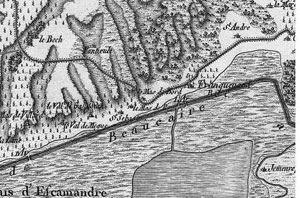A prestigious history ...
 The prestigious history of the Cistercian abbey of Franquevaux begins in the middle of the twelfth century in the “Casturm Belvedin” ( Beauvoisin Castel).
It would have belonged to the Knights Templar before returning to the Nimes ‘s Viscount family
The prestigious history of the Cistercian abbey of Franquevaux begins in the middle of the twelfth century in the “Casturm Belvedin” ( Beauvoisin Castel).
It would have belonged to the Knights Templar before returning to the Nimes ‘s Viscount family
The former Abbey of Franquevaux is restored and converted into cottages and B & Bs
In 1141 a group of monks sent by the young Cistercian Order requires the hospitality of Lord Peter Belvedin. They had crossed France on foot, led by the father Abbot Galthérius in order to build an abbey. After a long prospecting, he decided to settle in the middle of the Camargue countryside.
In 1143 a gentleman of the country, named Pons-Guillaume, In 1143 a gentleman of the country, named Pons-Guillaume made the donation of the land at the edge of the Scamandre lake (ancient inland sea). The bishop of Nîmes, Aldebert, endorses this decision, making Galthérius (Gautier) the first abbot of this spiritual epic
The abbey will be built over seventy years with stones from Fontvieille quarries. It quickly becomes one of the most important abbey of Languedoc. The popular tradition claims that there was in this place a former city called Caramignan.
No written document confirms this tradition, near the chapel you can see the ground strewn with bricks and Roman tiles. On the ruins of the Abbey, a charming small village was built with a large part of its stones, Franquevaux which has now over a hundred inhabitants.
Located near the Rhône Canal in Sète, on a road that is lost in the middle of ponds and reeds. between black and white from horses and bulls, the village is quiet and peacefull
